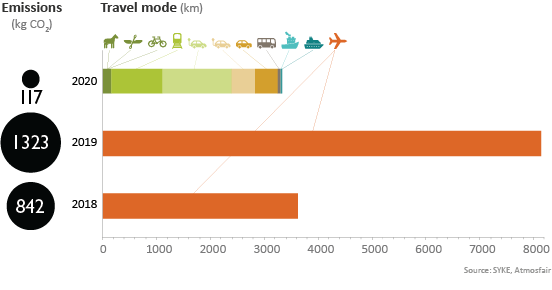Did Covid-19 affect your holiday plans this summer? According to a 2019 report, Finns were in second place for adjusted per capita aviation emissions, producing around a tonne of carbon dioxide annually, the world average being under 100 kilos. Traveling has been a part of my life for as long as I can remember, and it’s ironically what awoke me to the climate crisis. Having studied abroad, my summers always involved at least one return flight just to visit home. After starting work at SYKE I decided to really reduce my air travel. Yet, some unmissable life occasions came up abroad and flying was the most reasonable way to attend. This year I was very much looking forward to my first summer “on the ground”, where at most I’d thought of possibly seeing some European friends by rail. So I was pleased when Covid-19 halted international travel, giving me the perfect excuse to stay in Finland.
In May, Finland’s Ministry for Economic Affairs and Employment was predicting a 50-60% hit to the demand in domestic travel, which normally accounts for over half of all travel demand. According to an international survay, 1.8 million Finns had to cancel or postpone their holidays between January and April, while 58% (3.2 million) changed their plans for the second half of the year. Finnish tabloids were reporting on record amounts of people staycationing and several companies being overwhelmed with demand.
This boom in domestic travel also affected spending – throughout the summer I heard of various items having sold out: bikes, hammocks and cabin rentals were particularly popular among our nature loving nation. Media coverage on the most popular spots spread travellers further afield; in some places so much so that business nearly stopped altogether. Road trips by car spread my friends across the nation in search of new sights to see, but I also heard about a person who decided to cycle each street in Helsinki in alphabetical order, having now completed 175 streets and almost 2000 km. Another was hiking the full length of Finland – over 1000km South to North.
I chose many nature activities: a bike & boat ride near Tampere, kayak & hammock touring in lake Saimaa, a horse trek here and there along with a few shorter berry picking, mushroom foraging strolls in the woods. As my summer involved a fair amount of traveling, I wanted to see how it compared to previous ones with European flights, roughly, in terms of emissions. Assessing this turned out to be no easy task, but eventually I ended up with the following graphic, which includes nearly all trips travelled during my holiday this July compared with flights from the last two summer holidays.

Emissions and kilometres travelled during summer holidays by land in 2020 compared with emissions and kilometres travelled by air in 2018 (Finland to Scotland incl. 4 flight legs) and 2019 (return trips to France and England, 5 flight legs altogether). See Calculations for more details.
I had expected the emissions to be lower, but I am shocked by how much. Even excluding all the other trips of 2018 or 2019, my travel emissions from this summer were a fraction of a non-stop return flight from Helsinki to Paris. With all the generalisations I made, the true figures could even be smaller, considering for instance that on many occasions the EV was charged on the road at various fast charging stations which use 100% renewables. Our stop in Hamina was actually extended for the duration of a slower charge, which allowed us to have vegan lunch at the central square, stroll around the bastion, grab a coffee and spot Europe’s largest flagpole.
On my travels I got to visit 10 Hinku-municipalities, see their tourist attractions, test their public charging stations and sample their vegan offerings (which has vastly improved just in the last few years). Choosing to travel in a slower, lower-carbon way means seeing things you normally might miss, like a miniature world by the old road not far off the big motorway or catching a few glimpses of the endangered Saimaa ringed seal from our kayaks on the last evening of our trip. So, in spite of all the misery Covid-19 has and continues to bring with it globally, maybe it has also taught us some valuable lessons about rediscovering, appreciating and preserving what’s already around us. In my circles it definitely sparked important conversations that I believe might lead to changes for the better. What did you discover this summer?
I’m Venla Riekkinen and I work as a Coordinator at the Centre for Sustainable Consumption and Production, working with climate change mitigation in cities, regions and the Hinku network in particular. In my free time I enjoy adventures, urban greenery and vegan food.
Sources
Calculations
Not every tonne of aviation CO2 is created equal (ICCT, 2019)
Matkailijoiden kulutus supistuu Suomessa koronapandemian vaikutuksesta 60-70 prosenttia vuonna 2020 (in Finnish) (TEM, 2020)
Koronaepidemian vaikutus suomalaisten matkailuun. Kansainvälinen kyselytutkimus kuluttajille Suomen maaraportti 25.5.2020 (in Finnish) (Haaga-Helia 2020)
Opinions of blog contributors do not necessarily reflect the official views and opinions of the Finnish Environment Institute